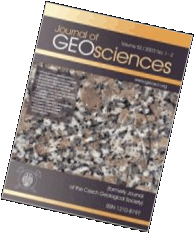Original Paper
Petrology and geochemistry of the Běstvina granulite body metamorphosed at eclogite facies conditions, Bohemian Massif
Journal of the Czech Geological Society, volume 50 (2005), issue 3-4, 95 - 106
DOI: http://doi.org/10.3190/JCGS.980
The high-pressure granulites from the Běstvina body contain a mineral association garnet-kyanite-biotite-plagioclase-K-feldspar-quartz ± antiperthite. Based on petrology, as well as major- and trace-element whole-rock geochemistry, the studied eight samples can be subdivided into four types: (1) metamorphosed greywacke, (2) felsic granulite with a low CaO/Na2O and K2O/Na2O ratio (type I), (3) felsic granulite of leucogranitic composition (type II), and (4) kyanite-garnet-biotite migmatitic gneiss. These rocks are associated with minor garner peridotite and a crustal eclogite with a prograde metamorphic record, as described in the literature. Garnet in the quartz-feldspathic rocks typically contains 24-35 mol. % Prp and 5-14 mol. % Grs components with Ca zoning across grains. Using compositions of garnet cores and the associated plagioclase and biotite, the geothermobarometric calculations prove the equilibration under eclogite facies conditions (P = 1.8-2.2 GPa and T = 800-920 °C). Two of the samples important for thermobarometry (felsic granulites type I and II) are free of antiperthite. The associated Ky-Grt-Bt migmatitic gneiss recording conditions near 1.4 GPa and 670 °C may represent a foreign component in the Běstvina granulite body. Although one meta-greywacke sample shows incipient replacement of garnet by biotite + plagioclase, the other samples are free of a decompression recrystallization record. Thus the granulites of the Běstvina body stand in sharp contrast to the better known granulites in the Moldanubian Zone, by their lack of evidence for an extensive decompression recrystallization.
Webdesign inspired by aTeo. Hosted at the server of the Institute of Petrology and Structural Geology, Charles University, Prague.
ISSN: 1803-1943 (online), 1802-6222 (print)
email: jgeosci(at)jgeosci.org


IF (WoS, 2024): 1.3
5 YEAR IF (WoS, 2024): 1.4
Policy: Open Access
ISSN: 1802-6222
E-ISSN: 1803-1943
 Export to Mendeley
Export to Mendeley